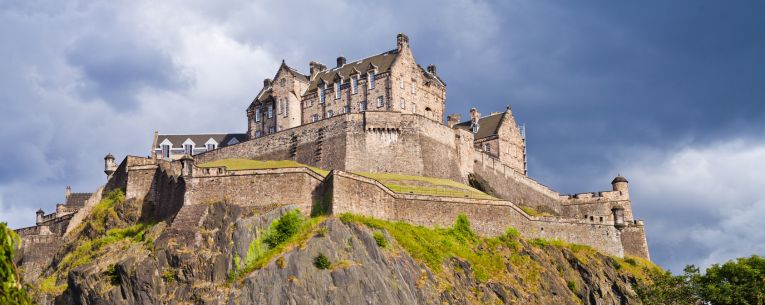Some people travel to experience different cultures. Some people travel to see sites of natural beauty, or to taste delightful new foods.
And then there are people like you, who travel seeking thrills—especially of the supernatural variety. Just for you, we’ve compiled a list of some of the scariest, eeriest places on Earth. (We’re only including places you can actually visit, so we have to omit destinations like Poveglia Island, the creepy islet near Venice that’s off-limits to all.)
Whether you’re traveling to someplace hauntingly beautiful or just plain haunted, remember to defend yourself with travel insurance. Discover why more than 70 million American travelers trust Allianz Travel Insurance to protect them every year: Get a quote for your next adventure.
Edinburgh Castle, Edinburgh
A lot of terrible things can happen in 900 years. Maybe that’s why so many ghosts flit about Edinburgh Castle, a hulking fortification that stands in the heart of the Scottish capital. Thousands of people have reported eerie experiences there, “including apparitions, being touched and pulled, the feeling of being watched, shadowy figures, mists, green lights, sudden temperature drops, and people suddenly becoming over-run by emotions,” according to ghost tour company Haunted Rooms.1
The most famous ghosts include a young bagpiper who was sent to map out the castle’s network of tunnels and never returned; Janet Douglas, known as the Grey Lady, who was falsely accused of treason and burned at the stake in 1537; and the ghosts of dogs who wander the castle’s cemetery for regimental mascots.
Read our Edinburgh destination guide.
Recoleta Cemetery, Buenos Aires
For two centuries, this ornate urban cemetery has been the resting place of thousands of Argentines. The most notable is Eva Perón, the beloved politician and First Lady. Following Perón’s death in 1952 and a political coup, her preserved body was stolen and interred in Milan, then retrieved and displayed in her husband’s house in Spain, and finally buried in La Recoleta.
That’s not even the strangest story you’ll encounter in La Recoleta. One of the most elaborate tombs belongs to Rufina Cambacérès, a young woman who collapsed and died suddenly in 1902, at age 19. Or so her family thought… According to Frommer’s, “a few days after her interment, workers heard screams from the tomb. When it was opened, there were scratches on her face and on the coffin from her attempts to escape.”2 Despite La Recoleta’s many tragic tales, it’s a peaceful and inviting place to visit today. Wander its winding paths, admire the elaborate monuments and sculptures, and say hola to a few of the many cats who call the cemetery home.
The Paris Catacombs
It seems completely improbable that you could venture under the Paris streets and find yourself among more than 6 million skeletons. But that’s exactly what you’ll see in the Paris Catacombs, which is undoubtedly one of the spookiest places in the world.
In the late 1700s, Paris ran out of places to bury its dead. City leaders decided to turn a series of abandoned limestone mines into a vast mausoleum, and so workers began unearthing old graves and carefully stacking and arranging bones in patterns.
Tours are limited to a small area of the catacombs. The network of abandoned mine tunnels is more than 200 miles long in total, so don’t go exploring on your own! A man named Philibert Aspairt died there in 1793 after losing his way; his remains weren’t found for 11 years.
Read our Paris destination guide.
Haw Par Villa, Singapore
Haw Par Villa is an unusual theme park that’s one of the spookiest places in Singapore. The inventor of Tiger Balm—the muscle-soothing ointment that comes in a metal tin—opened Haw Par Villa in 1937. There you’ll find more than a thousand sculptures of figures from Chinese folklore, literature, and faith traditions. The park’s infamous Ten Courts of Hell depict gruesome torments in the afterlife in Buddhism and Chinese mythology.
In the recently opened Hell’s Museum, visitors can explore other cultures’ conceptions of the underworld. “Tickets to hell are strictly non-refundable,” the website says. “There’s no turning back once you’ve decided to go to hell!” If this sounds more kitschy than scary, you should know that locals say the statues come to life at night.
Bhangarh Fort, Rajasthan, India
Constructed in the 17th century and now in ruins, Bhangarh Fort is considered by many to be the most haunted place in India. With or without a guide, you can explore the fort’s crumbling temples, palaces and havelis (manor homes).
According to local legend, the fort’s demise was foretold even before it was built. Its site was a meditation spot for a sadhu, or holy man, named Baba Balau Nath. When Raja Madho Singh chose the location for his fort compound, the sadhu gave his permission on one condition: that no building should be taller than his house. If the shadow of a building ever fell upon his home, the entire town would be destroyed. Two generations later, Singh’s grandson built the fort higher… and mysteriously, the place became abandoned.3 Today, tourists are invited to visit the site, but only during the daytime.
Actun Tunichil Muknal Cave, Belize
“Sparkling, calcite-covered skeletons of children who may have been sacrificed to appease an angry god.” This pithy summary from Atlas Obscura sums up why the ATM Cave, as it’s popularly known, is one of the world’s spookiest places to visit.
A trip to the cave is best suited for active adventurers. After driving into the jungle, you have to hike another 40 minutes to reach the entrance. You’re only allowed to enter with a licensed guide, as the trek into the cave requires hours of wading, swimming, and climbing.4 (This is a good time to mention that Allianz Travel Insurance plans exclude coverage for high-risk activities, including caving.)
At the end of the journey, you’ll see ancient tools, ceramics, and the bones of children and adults from Mayan ritual sacrifices. A thousand years of mineral deposits have left some skeletons covered in calcite crystals. If you’re adventurous enough to visit the ATM Cave, treat the site with respect: Don’t touch any artifacts or cave formations.
Osorezan (Mt. Osore), Honshu, Japan
The sacred mountain Osorezan—“Fear Mountain”—is one of the most otherworldly sites in Japan. Located on a remote peninsula in the northernmost reaches of Honshu, Osorezan stands in a gray and barren landscape. Sulfurous smoke rises from volcanic fumaroles. Nearby is a shimmering turquoise lake with acidic water that’s hostile to most aquatic life.
In the Buddhist tradition, Mount Osore is said to mark the entrance to hell. The nearby Sanzu no Kawa stream must be crossed by souls on their way to the afterlife. But it’s not a haunted place as much as a sorrowful one. Parents who have lost children come to the shrine here to mourn them, leaving pinwheels and small piles of pebbles as offerings to Jizō Bodhisattva. During annual festivals, mediums offer the chance to communicate with those who have passed on.5
Related Articles








Share this Page